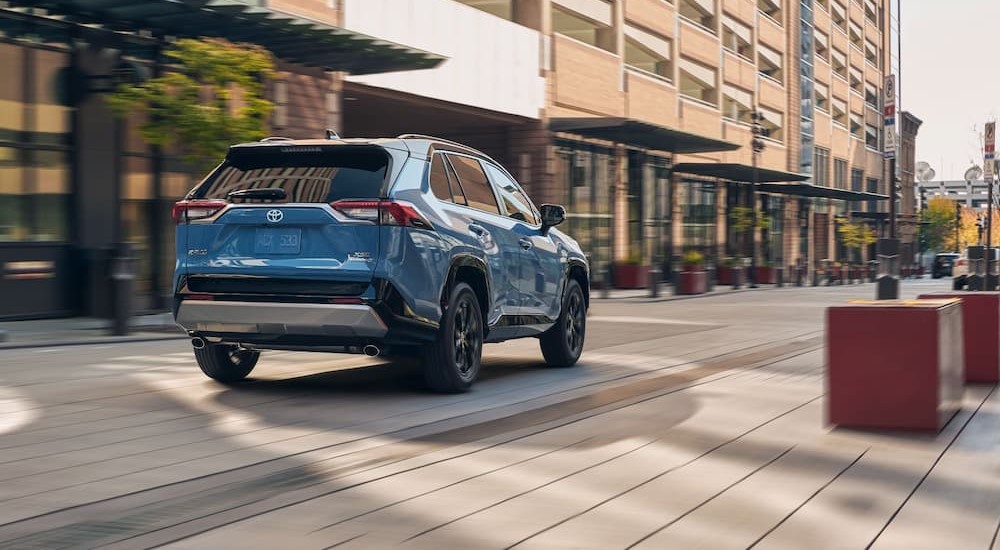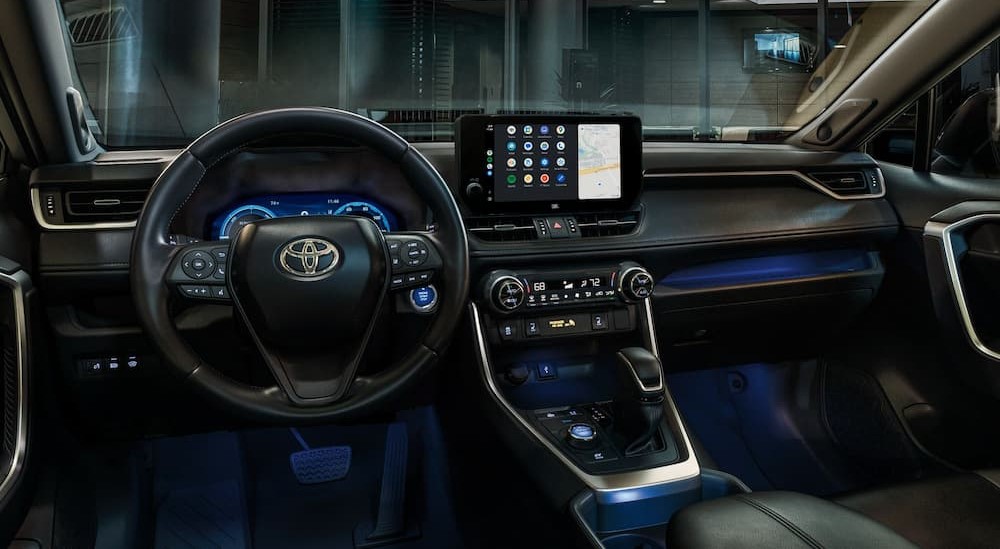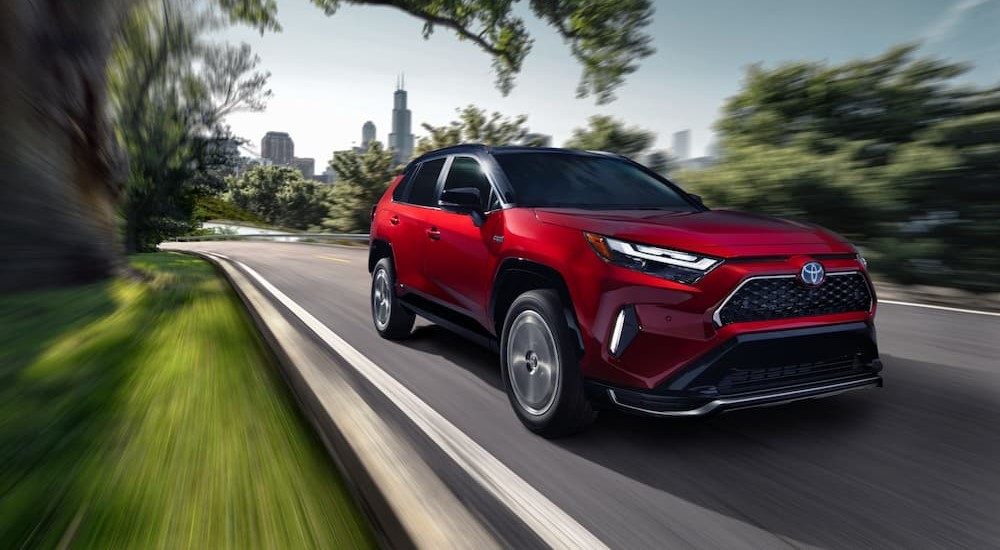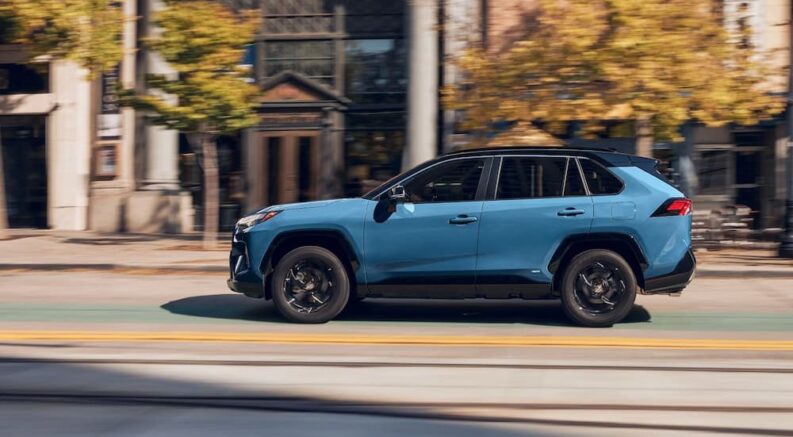From traditional hybrids and plug-in hybrid (PHEV) models to a new generation of all-electric vehicles (EVs), parsing the differences between different types of alternative-fuel vehicles can be challenging for even the most experienced driver. Things aren’t made any easier by the fact that automakers have fallen into the habit of producing hybrids and PHEVs that share a name with their gas-powered forerunners.
Take the Toyota RAV4, for example; Toyota’s best-selling compact crossover has been on the road since 1995 in its gas-powered form, but the automaker introduced a hybrid version in 2016 and a new PHEV model in 2021. Called the RAV4, RAV4 Hybrid, and RAV4 Prime, respectively, these models might share the same Toyota badge and styling, but the goods under the hood are a whole different story. Drivers in the market for a Toyota RAV4 Hybrid for sale might be understandably confused by the range of RAV4 models—but we’re here to help.

Hybrid vs Plug-In Hybrids
As the name implies, hybrids combine gas and electrical power to create a new, greener type of powertrain that offers some substantial benefits. Pop the hood on a hybrid or PHEV, and you’ll still find the same gas engine you’ve come to recognize… plus a little something extra.
The familiar internal combustion engine and transmission will be there, but so will an electric motor, generator, battery, thermal cooling system, and all the other components required for a partially electrified powertrain. Depending on the type of hybrid you’re dealing with, the gas and electric motors will either work in tandem or pass off propulsion duties between one another based on speed, acceleration, fuel levels, and other factors.
If wrapping your head around a whole new type of drivetrain wasn’t tricky enough, there’s one more wrinkle to consider when discussing hybrid vehicles. While the term “hybrid” is used pretty loosely, hybrid vehicles actually come in two different flavors: full hybrid vehicles and plug-in hybrids (PHEV). The distinction might seem a little fussy, but—in reality—hybrids and PHEVs are really two entirely different kinds of vehicles.
Hybrids and PHEVs both use a combination of gas engines and electric motors, and both are built with lithium-ion batteries, but the biggest difference between the two comes down to the size of the battery and how it’s used. In a PHEV, the battery does the brunt of the work, powering the vehicle with 100% electricity right up until it’s depleted. At that point, the gas engine kicks into action, extending the vehicle’s range and ensuring that drivers aren’t left stranded because of a lack of nearby charging stations. If you stick to a rigorous charging schedule, a PHEV can be almost indistinguishable from an all-electric vehicle, which brings some obvious benefits in terms of cost savings and environmental impact.
Hybrids, on the other hand, rely a lot more on that good old-fashioned internal combustion. While hybrids can travel at low speeds on 100% electric power, any high-speed applications are going to require assistance from the gas engine. Today, the average PHEV has an all-electric range of around 35 miles, while a conventional hybrid is usually limited to between 10 and 30 miles. Given the importance of the battery in a PHEV, it’s no surprise to learn that they’re much larger than the power packs found in hybrid vehicles. In the case of the 2023 Toyota RAV4 Hybrid, you’re looking at a 1.6-kWh battery as opposed to an 18.1-kWh pack in the Prime PHEV.
Hybrids were the first alternative fuel vehicles to really take hold in the modern market, with iconic models like the Prius paving the way for all PHEVs and EVs to come. The technology is a little basic when compared to these later iterations, but hybrids still represent a marked improvement over gas-powered vehicles while bypassing the charging, range, and convenience limitations of PHEVs and EVs.
The batteries in PHEVs are also larger—and more expensive—than those of hybrid vehicles due to the fact that they need to be able to power the entire vehicle. They’re also more power-hungry, which means that—unlike hybrid vehicles—PHEVs need to be connected to an external charger to top off their batteries. In contrast, hybrids can get away with recharging their batteries entirely through regenerative braking, which feeds a little juice to the battery every time you slow your vehicle.

Mild vs Full Hybrid
There’s one more important distinction to make when discussing hybrid vehicles, and that’s the difference between full and mild hybrids. In a mild hybrid, the electric motor only kicks into action when the gas engine needs a bit of a helping hand, like when accelerating from a full stop; this brief bump of power goes a long way in improving the hybrid’s efficiency, allowing it to achieve better fuel economy than a fully gas-powered vehicle. The battery in a mild hybrid is also used to power various electric systems throughout the vehicle, like the stereo, heating, and air conditioning.
A full hybrid vehicle is almost the inverse. Rather than primarily relying on a gas engine with occasional assistance from the electric motor, a full hybrid is primarily powered by electricity. The gas engine can lend a helping hand when accelerating from a stop or attempting to pass another driver at higher speeds—but, for the most part, it’s just there to extend the vehicle’s range once the battery is fully depleted. Some hybrid models will see the gas engine get a little action as it passes off propulsion duties with the electric motor, but no matter the model, a full hybrid is always going to be less reliant on gas than a mild hybrid.
So, what do the two types of hybrids compare regarding fuel efficiency? A mild hybrid will typically see a 10% to 15% improvement over its fully gas-powered cousins, but this can’t compare with full hybrids. In stop-and-go city driving conditions, a full hybrid like the Toyota RAV4 will see an almost 50% increase in fuel economy when compared to the internal combustion version. The gulf is a little less pronounced during highway driving, where hybrids tend to utilize their gas engines a little more often—but it is definitely still noticeable, with a 12% improvement over gas models on average.
Electrifying the RAV4
Let’s put what we’ve learned about hybrids and PHEVs into action as we take a closer look at the 2023 Toyota RAV4 Hybrid. We’ll start under the hood, where you’ll find a 2.5-liter four-cylinder engine paired with two electric motors for a total output of 220 hp. The instant torque offered by the SUV’s electric motors means that the hybrid can speed from zero to sixty in 7.3 seconds, which is a 0.7-second improvement over the gas-powered version. The RAV4 Prime trades the Hybrid’s three AC motors for three permanent-magnet synchronous motors and an 18.1-kWh battery that gives the PHEV version some 302 hp, which is good enough for a zero-to-sixty time of 5.6 seconds.
The RAV4 Hybrid comes standard with all-wheel drive and a continuously variable transmission (CVT), which allow the crossover to get up to some light off-road antics, especially if you spring for the all-new Woodland Edition packed with a Toyota TRD suspension kit, roof rack, mud flaps, black exterior badging, and a set of all-season floor mats.
Range is often the most important consideration for a hybrid or EV driver, so how does the RAV4 stack up? The RAV4 Prime can operate in all-electric mode for over 40 miles, which should be more than enough for a day of casual, around-town driving. This crossover can be charged in as little as 2.5 hours when connected to a 240-volt outlet or 12 hours on a standard 120-volt connection. Given its standard hybrid nature, the RAV4 Hybrid doesn’t really compete with the PHEV in terms of mileage, with a total all-electric range of 0.6 miles.
Last—but certainly not least—there’s fuel economy. It’s what draws most customers to this segment to begin with, and the RAV4 certainly doesn’t disappoint with an EPA-estimated 41 MPG in the city and 38 MPG on the highway. Comparing the hybrid with the PHEV requires us to turn to miles-per-gallon-equivalent (MPGe), but no matter what metric you use, the Prime is the clear frontrunner with a combined fuel economy rating of 94 MPGe. Again, comparing the two models is a bit of an apples and oranges situation, but the fuel economy numbers do go a long way in illustrating just how efficient PHEVs like the RAV4 Prime can be.

Toyota’s Hybrid Family
Hybrids, PHEVs, and EVs represent an exciting new era in personal transportation, but familiarizing yourself with the ins and outs of these newfangled alternative fuel vehicles can be a bit of a steep learning curve. Hybrids represent the most affordable option on the market today, allowing drivers to enjoy the benefits of electric power without the headaches that can come with charging and range-related anxiety. Best of all, they’re nearly indistinguishable from traditional gas-powered cars while behind the wheel, which should ease the transition for drivers who are still unsure about the all-electric approach.
PHEVs represent a step up in terms of technology, giving drivers the ability to travel short distances without ever tapping into the gas tank. While they might be more expensive than hybrids, PHEVs are typically a lot more affordable in the long run when you consider the low operating cost. EVs might be a good choice for some drivers, but those living in rural areas that lack sufficient charging infrastructure might find the all-electric approach a bit impractical.
No matter which type of alternative fuel vehicle you choose, you can rest easy knowing that you’re doing your part for the environment and your wallet.

